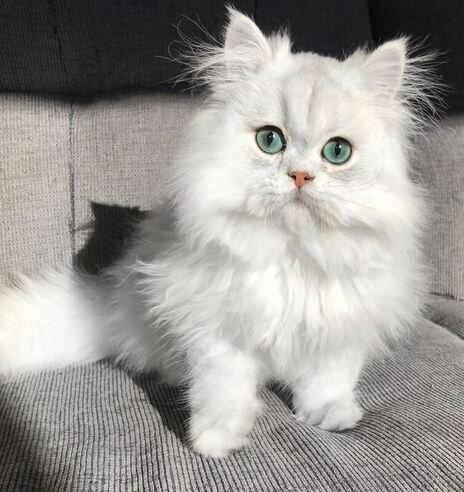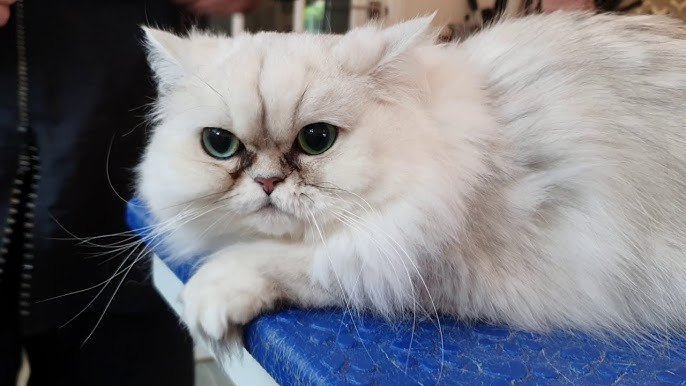Chinchilla
The Chinchilla cat, esteemed for its captivating beauty, exhibits a range of physical characteristics that contribute to its enchanting presence. These cats possess a luxurious long coat, characterized by a distinctive silvery-white coloration, where each hair is tipped with a darker hue, creating a shimmering effect. This striking appearance is complemented by their soft, plush fur that necessitates regular grooming to maintain its smooth and tangle-free texture. It is advisable for owners to establish a consistent grooming routine, ideally involving daily brushing to reduce matting and to keep the coat looking immaculate.

Another notable feature of the Chinchilla cat is its mesmerizing eyes, which are typically large and round, giving them a sweet, expressive gaze. The eye color can vary, often showcasing shades of green or blue, further enhancing the cat’s ethereal appearance. These vivid eyes are a striking contrast to their delicate fur, captivating everyone who encounters this breed. The overall size and shape of the Chinchilla cat are also noteworthy; they tend to have a compact body with a rounded face and short, sturdy limbs, which adds to their overall aesthetic appeal.
To ensure that a prospective owner selects a healthy Chinchilla cat, it is essential to pay attention to their physical features. A healthy Chinchilla will have a vibrant coat without bald spots and clear, bright eyes free from discharge. Potential owners are encouraged to seek reputable breeders who prioritize the health and well-being of their cats, as this will also provide insights into the serological and genetic health of prospective pets. In addition to their striking appearance, Chinchilla cats bring a layer of beauty to any household with their charming personality and elegance, making them a desired choice among cat enthusiasts.

Personality
The Chinchilla cat is known for its distinct personality traits that set it apart from other feline breeds. They are often described as gentle, affectionate, and remarkably social creatures. Unlike some cat breeds that prefer solitude, Chinchilla cats thrive in a family environment, often forming strong attachments to their human companions. This breed exhibits a playful demeanor, frequently engaging in games and interactive activities that stimulate their intellect and physical agility.
One unique aspect of the Chinchilla cat’s personality is its calm and laid-back nature. These cats tend to be more tolerant of handling and do not usually react aggressively when cuddled or picked up, which makes them excellent companions for families with children or other pets. However, each Chinchilla cat can possess distinct temperament traits; some may be more reserved while others are remarkably outgoing and sociable. Understanding the individuality within the breed is essential for potential owners, as it influences how well one integrates a Chinchilla cat into their household.
Moreover, Chinchilla cats often exhibit curious behavior and enjoy exploring their surroundings. They appreciate interactive toys and puzzle feeders that challenge their minds and keep them entertained. Social interaction is crucial for them; hence, they may become bored or anxious if left alone for prolonged periods. Their affectionate nature means they often seek attention and enjoy being part of family activities. Therefore, prospective owners should be prepared to invest time and effort in bonding with their Chinchilla cat, ensuring they remain happy and stimulated within their new home.
Origins
The Chinchilla cat breed has a rich history that can be traced back to the early 1900s. Its origins are deeply rooted in the development of Persian cats, from which the Chinchilla lineage descends. Breeders sought to create a cat with delicate features alongside a luxurious, silken coat, resulting from selective breeding practices that emphasized these characteristics. The initial breeding efforts aimed to produce a feline that would capture the elegance associated with both the Chinchilla fur’s color and texture.

One of the pivotal moments in the history of the Chinchilla cat occurred in the late 19th century with an increased appreciation for exotic breeds. While Persian cats were already revered, the introduction of the Silver Persian in teddy bear style fur varieties laid the groundwork for the distinctive features we associate with the Chinchilla breed today. The shaped face, striking green eyes, and considerable plushness of the coat became the trademarks of this breed, drawing the interest of cat enthusiasts around the world.
The official recognition of the Chinchilla cat by several cat registries marks another significant milestone in its history. Organizations such as The International Cat Association (TICA) and the Cat Fanciers’ Association (CFA) acknowledged the Chinchilla as a distinct breed, solidifying its status within the feline world. This recognition spurred further breeding programs focused on enhancing the physical characteristics and temperament of the Chinchilla cat, contributing to its allure among pet owners.
As the 20th century progressed, the Chinchilla cat’s distinctive beauty and charming personality garnered attention, resulting in a rise in popularity among cat lovers. Today, the breed not only serves as a companion but also stands as a representation of exquisite breeding practices aimed at creating a feline that embodies grace and beauty.
Care of the Chinchilla cat
Caring for a Chinchilla cat requires a thoughtful approach to ensure their well-being and happiness. Firstly, diet plays a crucial role in maintaining their health. It is recommended to provide a high-quality, balanced cat food that is specifically formulated for their nutritional needs. Look for options that list meat as the primary ingredient and avoid fillers such as corn and soy. Additionally, consider incorporating wet food into their diet to help with hydration.
Regular veterinary check-ups are essential in preventing potential health issues. Chinchilla cats can be susceptible to certain genetic conditions, such as hypertrophic cardiomyopathy and dental problems. Routine examinations can help detect these issues early, ensuring timely intervention. It is advisable to maintain vaccinations and regular dental care to further promote their overall health.
Chinchilla cats also require adequate exercise to maintain a healthy weight and prevent behavioral problems. Engage them with interactive toys, climbing structures, and regular play sessions to keep their minds stimulated and bodies active. Behavioral needs should not be overlooked; these cats thrive on social interaction, so spending quality time with your Chinchilla will strengthen your bond and fulfill their need for companionship.
Enrichment activities can enhance their environment and reduce potential stressors. Introduce scratching posts, puzzle feeders, and perches to encourage exploration and mental stimulation. Furthermore, when introducing new elements to their surroundings, ensure to do so gradually, allowing them time to adjust.
By understanding and addressing the unique needs of Chinchilla cats, owners can foster a nurturing habitat that allows these beautiful felines to thrive. This includes recognizing common health issues and being proactive about addressing any emerging concerns, which contributes to their overall quality of life.
Health
The Chinchilla cat breed is generally healthy but prone to hereditary conditions like polycystic kidney disease (PKD) and respiratory issues due to their flat faces. Regular vet check-ups, a balanced diet, and proper grooming help maintain their well-being. Preventative care is key to ensuring a long, happy life for your Chinchilla cat.
Nutrition
The Chinchilla cat thrives on a balanced diet rich in high-quality protein, healthy fats, and essential nutrients. Prioritize premium wet or dry cat food with real meat as the main ingredient, avoiding fillers and artificial additives. Omega-3 and omega-6 fatty acids support their luxurious coat, while taurine promotes heart health. Fresh water should always be available, and occasional treats can be given in moderation. Consult a vet for personalized dietary recommendations to maintain optimal weight and overall well-being.
Cleanliness
The Chinchilla cat is known for its luxurious, long fur, but surprisingly, it requires moderate grooming to stay clean. With a silky coat that resists matting and minimal shedding, regular brushing (2-3 times per week) keeps them pristine. These cats are naturally clean, frequently grooming themselves, and prefer a tidy environment. Their white, shimmering fur stays bright with occasional baths and routine eye cleaning to prevent tear stains. A perfect breed for those who appreciate elegance with manageable upkeep.
Best cat breeds for kids
The Chinchilla cat is a gentle and affectionate breed, perfect for families with children. Known for its luxurious silver or golden coat and emerald-green eyes, this cat is both stunning and friendly. Chinchillas are playful yet calm, enjoy human companionship, and adapt well to family life. Their sweet nature and patience make them an excellent choice for kids looking for a loving feline friend.
People who have seen this breed have also visited…
In this section you can find completely detailed information about the breed of your cat.
